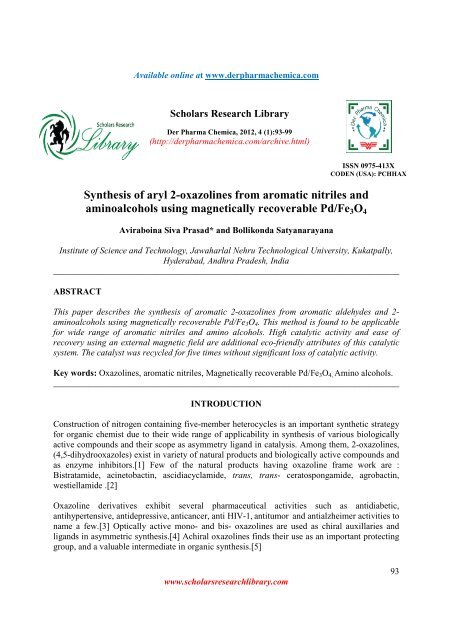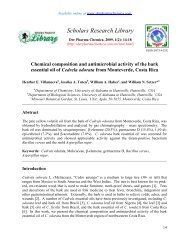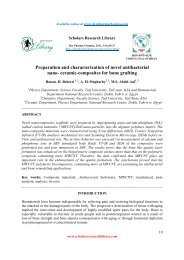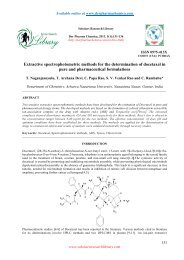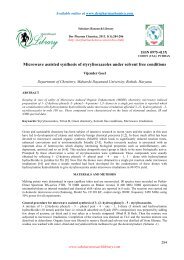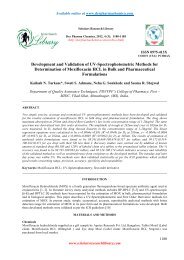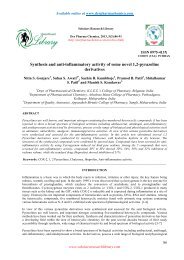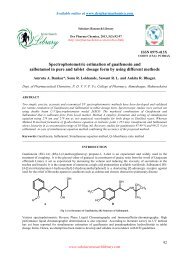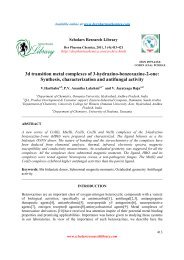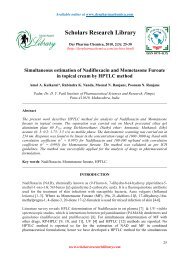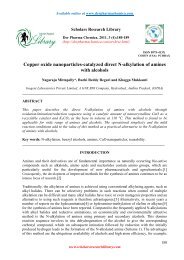Synthesis of aryl 2-oxazolines from aromatic nitriles - Der Pharma ...
Synthesis of aryl 2-oxazolines from aromatic nitriles - Der Pharma ...
Synthesis of aryl 2-oxazolines from aromatic nitriles - Der Pharma ...
Create successful ePaper yourself
Turn your PDF publications into a flip-book with our unique Google optimized e-Paper software.
Available online at www.derpharmachemica.com<br />
Scholars Research Library<br />
<strong>Der</strong> <strong>Pharma</strong> Chemica, 2012, 4 (1):93-99<br />
(http://derpharmachemica.com/archive.html)<br />
ISSN 0975-413X<br />
CODEN (USA): PCHHAX<br />
<strong>Synthesis</strong> <strong>of</strong> <strong>aryl</strong> 2-<strong>oxazolines</strong> <strong>from</strong> <strong>aromatic</strong> <strong>nitriles</strong> and<br />
aminoalcohols using magnetically recoverable Pd/Fe 3 O 4<br />
Aviraboina Siva Prasad* and Bollikonda Satyanarayana<br />
Institute <strong>of</strong> Science and Technology, Jawaharlal Nehru Technological University, Kukatpally,<br />
Hyderabad, Andhra Pradesh, India<br />
______________________________________________________________________________<br />
ABSTRACT<br />
This paper describes the synthesis <strong>of</strong> <strong>aromatic</strong> 2-<strong>oxazolines</strong> <strong>from</strong> <strong>aromatic</strong> aldehydes and 2-<br />
aminoalcohols using magnetically recoverable Pd/Fe 3 O 4 . This method is found to be applicable<br />
for wide range <strong>of</strong> <strong>aromatic</strong> <strong>nitriles</strong> and amino alcohols. High catalytic activity and ease <strong>of</strong><br />
recovery using an external magnetic field are additional eco-friendly attributes <strong>of</strong> this catalytic<br />
system. The catalyst was recycled for five times without significant loss <strong>of</strong> catalytic activity.<br />
Key words: Oxazolines, <strong>aromatic</strong> <strong>nitriles</strong>, Magnetically recoverable Pd/Fe 3 O 4, Amino alcohols.<br />
______________________________________________________________________________<br />
INTRODUCTION<br />
Construction <strong>of</strong> nitrogen containing five-member heterocycles is an important synthetic strategy<br />
for organic chemist due to their wide range <strong>of</strong> applicability in synthesis <strong>of</strong> various biologically<br />
active compounds and their scope as asymmetry ligand in catalysis. Among them, 2-<strong>oxazolines</strong>,<br />
(4,5-dihydrooxazoles) exist in variety <strong>of</strong> natural products and biologically active compounds and<br />
as enzyme inhibitors.[1] Few <strong>of</strong> the natural products having oxazoline frame work are :<br />
Bistratamide, acinetobactin, ascidiacyclamide, trans, trans- ceratospongamide, agrobactin,<br />
westiellamide .[2]<br />
Oxazoline derivatives exhibit several pharmaceutical activities such as antidiabetic,<br />
antihypertensive, antidepressive, anticancer, anti HIV-1, antitumor and antialzheimer activities to<br />
name a few.[3] Optically active mono- and bis- <strong>oxazolines</strong> are used as chiral auxillaries and<br />
ligands in asymmetric synthesis.[4] Achiral <strong>oxazolines</strong> finds their use as an important protecting<br />
group, and a valuable intermediate in organic synthesis.[5]<br />
www.scholarsresearchlibrary.com<br />
93
Aviraboina Siva Prasad et al <strong>Der</strong> <strong>Pharma</strong> Chemica, 2012, 4 (1):93-99<br />
_____________________________________________________________________________<br />
Numerous methods for the construction <strong>of</strong> 2-<strong>oxazolines</strong> have been reported, <strong>from</strong> carboxylic<br />
acids, esters, <strong>nitriles</strong>, aldehydes, hydroxyamides and <strong>from</strong> olefins.[6] Adolfsson and co-workers<br />
prepared chiral 2-(aminoalkyl)<strong>oxazolines</strong> <strong>from</strong> α-amino acids and 1,2-amino alcohols by<br />
conventional method and later some <strong>of</strong> them have developed a synthesis <strong>of</strong> <strong>oxazolines</strong> by using<br />
carboxylic acids and amino alcohols.[7] Furthermore, Natale and co-workers and Mashima and<br />
co-workers were developed a one-pot direct synthesis <strong>of</strong> 2-<strong>oxazolines</strong> <strong>from</strong> ester and amino<br />
alcohols using LnCl 3 and Zinc triflate respectively.[8] Recently Bedekar and co-workers found<br />
that natural kaolinitic clay as an effective as catalyst for the conversion <strong>of</strong> <strong>aromatic</strong> and aliphatic<br />
<strong>nitriles</strong> with 1, 2-aminoalcohol to 2-<strong>oxazolines</strong>.[9]<br />
Heterogeneous catalysis is particularly attractive as it allows the production and ready separation<br />
<strong>of</strong> large quantities <strong>of</strong> products with the use <strong>of</strong> a small amount <strong>of</strong> catalyst. Magnetic nanoparticles<br />
are a class <strong>of</strong> nanostructured materials <strong>of</strong> current interest, due largely to their advanced<br />
technological and medical applications, envisioned or realized.[10] Among the various magnetic<br />
nanoparticles under investigation, Fe 3 O 4 nanoparticles are arguably the most extensively<br />
studied[11] and recently emerged as promising supports for immobilization metal nanoparticles.<br />
Fe 3 O 4 -supported metal catalysts can be separated <strong>from</strong> the reaction medium by an external<br />
permanent magnet. Pd/Fe 3 O 4 was were prepared according to literature[12] and the amount <strong>of</strong><br />
palladium in the catalyst was determined with an inductively coupled plasma, atomic emission<br />
spectroscopy (ICPAES) instrument and Palladium content was measured as 0.14 mmolg -1 .<br />
In the present work, we report our investigations on the application <strong>of</strong> Fe 3 O 4 supported Pd(0)<br />
nanoparticles (Pd/Fe 3 O 4 ) for the synthesis <strong>of</strong> practical and atom-economic <strong>aromatic</strong> 2-<br />
<strong>oxazolines</strong> <strong>from</strong> the reaction <strong>of</strong> <strong>aromatic</strong> <strong>nitriles</strong> and 2-aminoalcohols (Scheme 1).<br />
Scheme 1<br />
MATERIALS AND METHODS<br />
4. Experimental Section<br />
4.1. General<br />
All chemicals were purchased <strong>from</strong> Sigma-Aldrich and S.D Fine Chemicals, Pvt. Ltd. India and<br />
used as received. ACME silica gel (100–200 mesh) was used for column chromatography and<br />
thin-layer chromatography was performed on Merck-precoated silica gel 60-F 254 plates. All the<br />
other chemicals and solvents were obtained <strong>from</strong> commercial sources and purified using standard<br />
methods. The IR spectra <strong>of</strong> all compounds were recorded on a Perkin-Elmer, Spectrum GX FTIR<br />
spectrometer. The IR values are reported in reciprocal centimeters (cm -1 ). The 1 H, 13 C NMR<br />
spectra were recorded on a Varian- 400 MHz, Bruker-Avance 300 MHz Spectrometer. Chemical<br />
www.scholarsresearchlibrary.com<br />
94
Aviraboina Siva Prasad et al <strong>Der</strong> <strong>Pharma</strong> Chemica, 2012, 4 (1):93-99<br />
_____________________________________________________________________________<br />
shifts (δ) are reported in ppm, using TMS (δ =0) as an internal standard in CDCl 3 . ESI mass<br />
spectra were recorded on a Finnigan LCQ Advantagemax spectrometer.<br />
4.2. Typical experimental procedure:<br />
To a solution <strong>of</strong> benzonitrile (1 mmol), amino alcohol (1.2 mmol) in toluene (3 ml), Pd/Fe 3 O 4 (1.5<br />
mol %) was added. The reaction mixture was stirred at 100 o C and monitored by TLC. After<br />
completion <strong>of</strong> the reaction, the reaction mixture was quenched with NaHCO 3 solution. The<br />
aqueous layer was extracted with ethyl acetate (3 x 20 mL), and the combined organics were<br />
dried over anhydrous Na 2 SO 4 , concentrated in vacuo and purified by column chromatography on<br />
silica gel to afford the pure product. All products were characterized by IR, 1 H NMR, 13 C NMR<br />
and mass spectroscopic techniques.<br />
Reuse <strong>of</strong> Catalyst. After completion <strong>of</strong> the reaction the catalyst was recovered by filtration and<br />
washed several times with ethyl acetate and then ether and dried for further reuse. The catalyst<br />
showed consistent activity for five cycles.<br />
Spectroscopic data for the representative compounds:<br />
4.2.1. 5-methyl-2-phenyl-4,5-dihydrooxazole (Table 2, Entry 1): 1 H NMR δ(300 MHz,<br />
CDCl 3 ) 7.86 (d, J = 8.5 Hz, Ar, 2H), 7.54 (d, J = 8.2 Hz, 1H), 7.37 (d, J = 8.5 Hz, Ar, 2H), 4.70<br />
– 4.85 (m, 1H), 4.05 (dd, J = 9.3 Hz, 9.3 Hz, 1H), 3.52 (dd, J = 7.4 Hz, 7.4 Hz), 1.37 (d, J<br />
=6.1Hz, -CH 3 , 3H). EI MS (m/z): 161 (M + ).<br />
4.2.2. 5-methyl-2-p-tolyl-4,5-dihydrooxazole (Table 2, entry 2): 1 H NMR δ(300 MHz, CDCl 3 )<br />
7.80 (d, J = 7.9 Hz, Ar, 2H), 7.18 (d, J = 7.9 Hz, Ar, 2H), 4.77 – 4.87 (m, 1H), 4.11 (dd, J = 9.3<br />
Hz, 9.2 Hz, 1H), 3.57 (dd, J = 7.4 Hz, 7.2 Hz), 2.4 (s, -CH 3 , 3H), 1.43 (d, J = 6.0Hz, -CH 3 , 3H).<br />
EI MS (m/z): 175 (M + ).<br />
4.2.3. 4-ethyl-2-p-tolyl-4,5-dihydrooxazole (Table 2, Entry 7): 1 H NMR δ(300 MHz, CDCl 3 )<br />
7.82 (d, J = 8.1 Hz, Ar, 2H), 7.20 (d, J = 7.9 Hz, Ar, 2H), 4.46 (t, J = 7.9 Hz, 1H), 4.17- 4.43 (m,<br />
1H), 4.02 (t, J = 7.9 Hz, 1H), 2.42 (s, -CH 3 , 3H), 1.57 – 1.82 (m, 2H), 1.3 (t, J = 7.4 Hz, 7.4 Hz,<br />
3H). 13 C NMR (75 MHz, CDCl 3 ): 157.4, 137.1, 134.1, 131.7, 130.2, 120.6, 111.8, 56.1, 11.6. EI<br />
MS m/z 189 (M + ).<br />
4.2.4. 4-methyl-2-p-tolyl-4,5-dihydrooxazole (Table 2, Entry 12): 1 H NMR δ(300 MHz,<br />
CDCl 3 ) 7.81 (d, J = 7.9 Hz,Ar, 2H), 7.20 (d, J = 7.9 Hz, Ar, 2H), 4.51 (t, J = 9.0 Hz, 8.1 Hz, 1H),<br />
4.31- 4.43 (m, 1H), 3.94 (t, J = 7.5 Hz, 7.7 Hz, 1H), 2.42(s, -CH 3 , 3H), 1.38 (d, J = 6.6 -CH 3 ,<br />
3H). 13 C NMR (75 MHz, CDCl 3 ): 151.8, 149.3, 135.6, 124.9, 123.1, 74.2, 62.0, 29.6, 21.3. EI<br />
MS (m/z): 175 (M + ).<br />
RESULTS AND DISCUSSION<br />
In our initial studies, various solvents were investigated using benzonitrile and 1-aminopropan-2-<br />
ol as model substrates to know solvent effect on the synthesis <strong>of</strong> <strong>oxazolines</strong> (Table 1). The<br />
reaction conditions were optimized and the best conditions were found to be 1.5 mol % <strong>of</strong><br />
Pd/Fe 3 O 4 and toluene as the solvent as shown in Table 1, entry 1. By virtue <strong>of</strong> these optimized<br />
www.scholarsresearchlibrary.com<br />
95
Aviraboina Siva Prasad et al <strong>Der</strong> <strong>Pharma</strong> Chemica, 2012, 4 (1):93-99<br />
_____________________________________________________________________________<br />
conditions, the reaction afforded the desired product in 85 % yield. Subsequently, the reaction<br />
condition was optimized by employing different solvents, wherein various polar and non polar<br />
solvents were examined and it was found that all <strong>of</strong> them had negative influence on the reaction<br />
to different degrees (Table 1, entries 2 - 8).<br />
Table 1. Optimization <strong>of</strong> reaction conditions for the synthesis <strong>of</strong> oxazolinies. a<br />
a Reaction conditions: benzonitrile (1 mmol), 1-aminopropan-2-ol (1.2 mmol), Pd/Fe 3 O 4 (1.5 mol%) and solvent (3<br />
mL) at their reflux temperature.<br />
The general applicability <strong>of</strong> this reaction was evaluated with diverse aldehydes and amino<br />
alcohols. In case <strong>of</strong> 1-amino-propan-2-ol as the amino-alcohol variant, it was observed that the<br />
reaction yielded better results for electron releasing substrates (Table 2, entries 1-5). When 2-<br />
aminobutan-1-ol was taken the substrate, electron withdrawing aldehydes yielded better results<br />
than electron releasing one (Table 2, entries 6-10). Overall the yields are better compared to 1-<br />
amino-propan-2-ol. When the reaction was carried out with a hetero-<strong>aromatic</strong> aldehyde,<br />
pyridine-3-aldehyde and the yield was moderate (Table 2, entry 10).<br />
With 2-aminopropan-1-ol, electron withdrawing groups gave better yield compared to electron<br />
donating substrate. (Table 2, entry 11-15). Aliphatic aldehyde, n-butyraldehyde with 3-amino-4-<br />
phenylbutan-2-ol gave the desired oxazoline in reasonable amount (Table 2, entry 16).<br />
To check the recyclability <strong>of</strong> the catalyst, as can be seen <strong>from</strong> Table 3, the reaction was<br />
performed with benzonitrile and amino alcohol. The catalyst was separated <strong>from</strong> the reaction<br />
mixture by applying external magnetic field and reused without significant loss <strong>of</strong> catalytic<br />
activity.<br />
www.scholarsresearchlibrary.com<br />
96
Aviraboina Siva Prasad et al <strong>Der</strong> <strong>Pharma</strong> Chemica, 2012, 4 (1):93-99<br />
_____________________________________________________________________________<br />
Table 2: <strong>Synthesis</strong> <strong>of</strong> <strong>aromatic</strong> 2-<strong>oxazolines</strong> <strong>from</strong> different benzo<strong>nitriles</strong> and amino alcohols a<br />
a Reaction conditions: benzonitrile (1 mmol), amino alcohol (1.2 mmol), Pd/Fe 3O 4 (1.5 mol %) and toluene (3 mL) at 100 o C for 10 h.<br />
www.scholarsresearchlibrary.com<br />
97
Aviraboina Siva Prasad et al <strong>Der</strong> <strong>Pharma</strong> Chemica, 2012, 4 (1):93-99<br />
_____________________________________________________________________________<br />
Table 3. Recovery and reuse <strong>of</strong> Pd/Fe 3 O 4 nanoparticles for the synthesis <strong>of</strong> phenyl-2-oxazoline a<br />
a Reaction conditions: benzonitrile (1 mmol), amino alcohol (1.2 mmol), Pd/Fe 3O 4 (1.5 mol %) and toluene (3 mL) at 100 o C for 10 h.<br />
CONCLUSION<br />
It can be concluded that a simple and straightforward method for the synthesis <strong>of</strong> the oxazoline<br />
<strong>from</strong> benzonitrile and an amino alcohol using magnetically recoverable Pd/Fe 3 O 4 as the catalyst<br />
have been described. The reaction was carried out under milder condition and no other side<br />
products are obtained. The new catalytic reactions presented in this letter could be a meaningful<br />
addition to the existing methods<br />
REFERENCES<br />
[1] J. V. Greenhill, L. Lue, in: G.P. Ellis, D.K. Luscombe (Eds.), Progress in Medicinal<br />
Chemistry, vol. 3, Elsevier, NY, 1993.<br />
[2] (a) S. V. Downing, E. Aguilar, A. I. Meyers, J. Org. Chem. 1999, 64, 826; (b) W. M. Wuest,<br />
E. S. Sattely, C. T. Walsh J. Am Chem Soc. 2009, 131, 5056; (c) Y. Hamamoto, M. Endo, M.<br />
Nakagawa, T. Nakanishi, K. Mizukawa, Chem. Commun. 1983, 323; (d) Z. Chen, J. Deng, T. Ye,<br />
ARKIVOC, 2003, 268; (e) T. Peterson, J. B. Neilands, Tetrahedron Lett. 1979, 20, 4805; (f) G.<br />
Haberhauer, E. Drosdow, T. Oeser, F. Rominger, Tetrahedron , 2008, 64 , 1853.<br />
[3] (a) F. Rondu, G. Lr Bihan, X. Wang, A. Lamouri, E. Touboul, G. Dive, T. Bellahsene, B.<br />
Pfeiffer, P. Renard, B. Guardiola-Lemaı ˆtre, D. Mane´chez, L. Pe´nicaud, A. Ktorza, J. J.<br />
Godfroid, J. Med. Chem. 1997, 40, 3793; (b) P. Bousquet, J. Feldman, Drugs 1999, 58, 799; (c)<br />
E. S. Vizi, Med. Res. Rev. 1986, 6 , 431; (d) P. Wipf, P.C. Fritch, Tetrahedron Lett. 1994, 35,<br />
5397; (e) R. J. Boyce, G. C. Mulqueen, G. Pattenden, Tetrahedron Lett. 1994, 35, 5705; (f) P.<br />
Wipf, S. Venkatraman, Synlett 1997, 1; (g) M. Tomizawa, A. Cowan, J.E. Casida, Toxicol. Appl.<br />
<strong>Pharma</strong>col. 2001,177, 77.<br />
[4] (a) G. Desimoni, G. Faita, K. A. Jorgensen, Chem. Rev. 2006, 106, 3561; (b) H. A.<br />
McManus, P. J. Guiry, Chem. Rev., 2004, 104 (9), 4151.<br />
[5] (a) J. A. Frump, Chem. Rev. 1971, 71, 483; (b) T. W. Greene, P. G. M. Wuts, Protecting<br />
Groups in Organic <strong>Synthesis</strong>, 2nd ed. J. wiley: New York, 1991.<br />
[6] (a) P.J. Kocienski, Protecting Groups; Enders, D.; Noyori, R.; Trost, B.M., Eds.; George<br />
Thieme Verlag: Stuttgart, New York, 1994.<br />
[7] From Acids: (a) P. Vastila, I. M. Pastor, H. Adolfsson, J. Org. Chem. 2005, 70, 2921; (b) S.<br />
Rajaram, M. S. Sigman, Org. Lett., 2002, 4, 3399; (c) C. O. Kangani, D. E. Kelley, Tetrahedron<br />
Lett. 2005, 46, 8917; (d) A. Cwik, Z. Hell, A. Hegedus, Z. Finta, Z. Horvath, Tetrahedron Lett. 2002,<br />
43, 3985.<br />
[8] (a) P. Zhou, J. E. Blubaum, C.T. Bums, N. R. Natale, Tetrahedron Lett. 1997, 38, 7019; (b)<br />
T. Ohshima, T. Iwasaki, K. Mashima, Chem. Commun. 2006, 2711.<br />
www.scholarsresearchlibrary.com<br />
98
Aviraboina Siva Prasad et al <strong>Der</strong> <strong>Pharma</strong> Chemica, 2012, 4 (1):93-99<br />
_____________________________________________________________________________<br />
[9] (a) I. M. Baltork, V. Mirkhani, M. Moghadam, S. Tangestaninejad, M. A. Zolfigol, M.<br />
Abdollahi-Alibeik, A. R. Khosropour, H. Kargar, S. F. Hojati, Catal. Commun. 2008, 9, 894; (b)<br />
I. M. Baltork, M. Moghadam, S. Tangestaninejad, V. Mirkhani, S. F. Hojati, Catal. Commun.<br />
2008, 9, 1153; (c) G.K. Jnaneshwara, V.H. Deshpande, M. Lalithambika, T. Ravindranathan,<br />
A.V. Bedekar, Tetrahedron Lett. 1998, 39, 459.<br />
[10] (a) C. T. Yavuz, J. T. Mayo, W. W. Yu, A. Prakash, J. C. Falkner, S. Yean, L. L. Cong, H. J.<br />
Shipley, A. Kan, M. Tomson, D. Natelson, V. L. Colvin, Science 2006, 314, 964; (b) S. H. Sun,<br />
C. B. Murray, D. Weller, L. Folks, A. Moser, Science 2000, 287, 1989; (c) M. K. Yu, Y. Y.<br />
Jeong, J. Park, S. Park, J. W. Kim, J. J. Min, K. Kim, S. Jon, Angew. Chem., Int. Ed. 2008, 47,<br />
5362.<br />
[11] (a) A. G. Roca, M. P. Morales, K. O’Grady, C. J. Serna, Nanotechnology 2006, 17, 783; (b)<br />
Y. H. Zheng, Y. Cheng, F. Bao, Y. S. Wang, Mater. Res. Bull. 2006, 41, 525; (c) C. Lang, D.<br />
Schueler, D. Faivre, Macromol. Biosci. 2007, 7, 144; (c) P. Majewski, B. Thierry, Crit. Rev.<br />
Solid State Mater. Sci. 2007, 32, 203.<br />
[12] D. Guin, B. Baruwati, S. V. Manorama, Org. Lett. 2007, 9, 1419.<br />
www.scholarsresearchlibrary.com<br />
99


